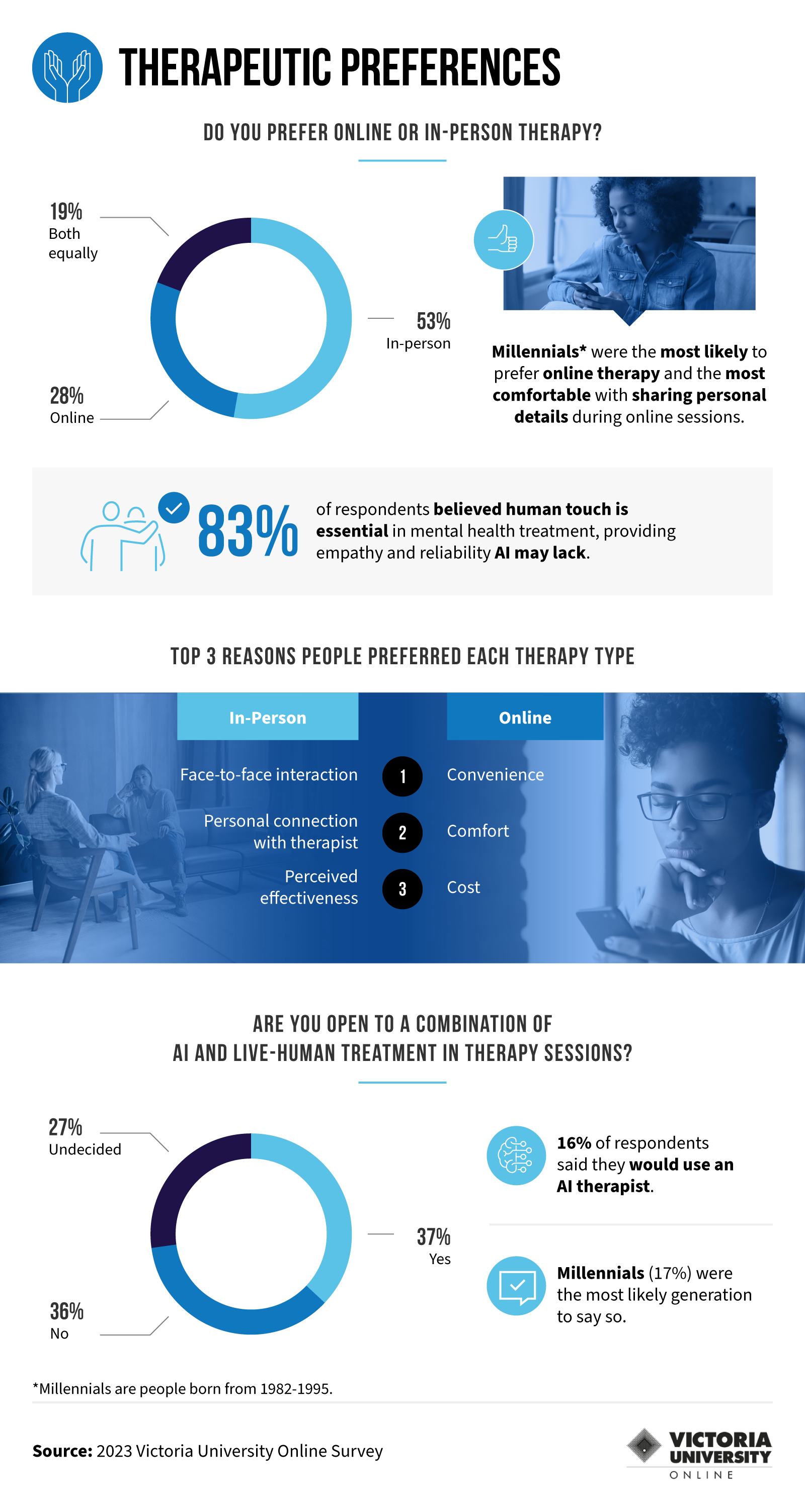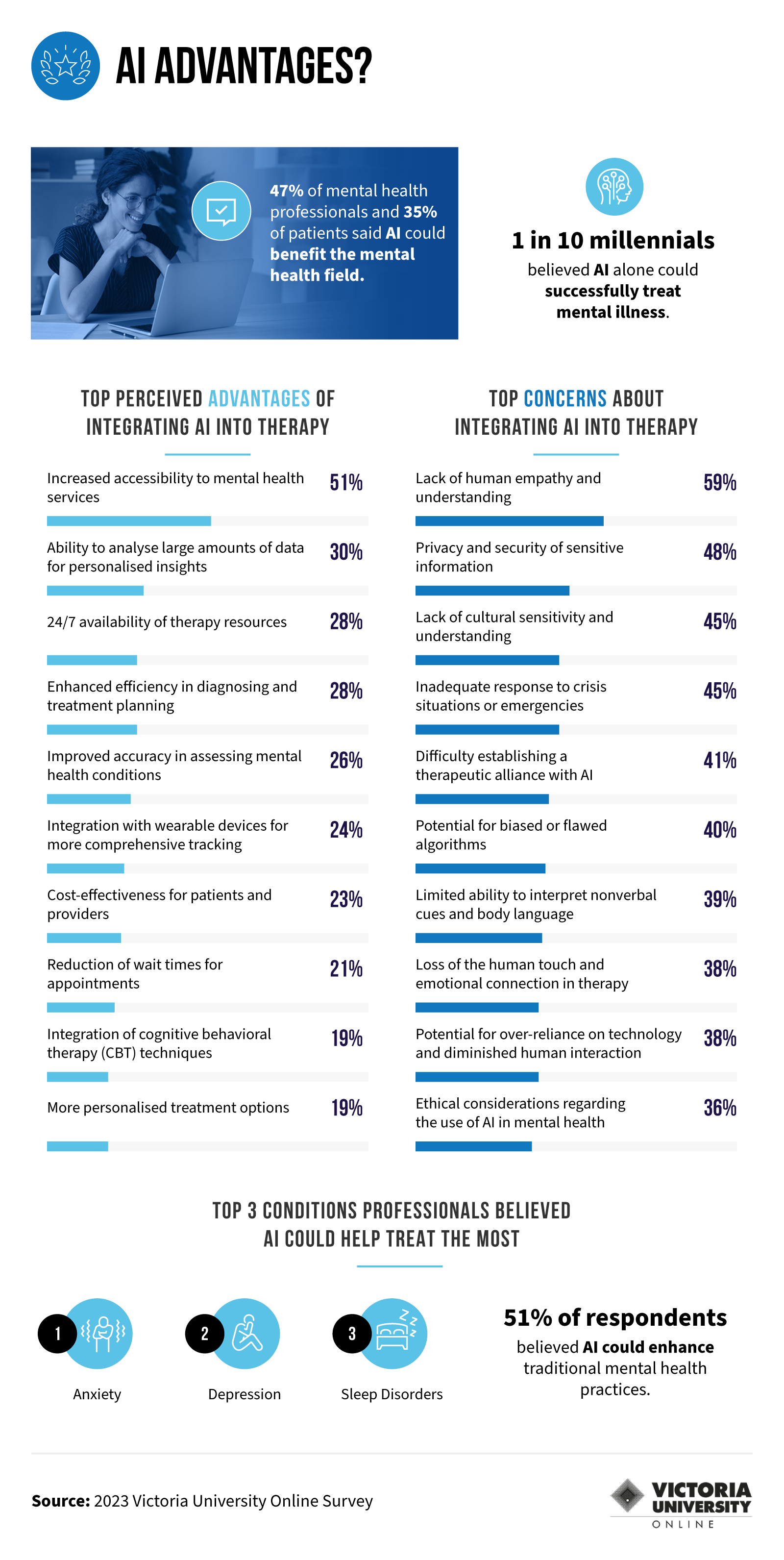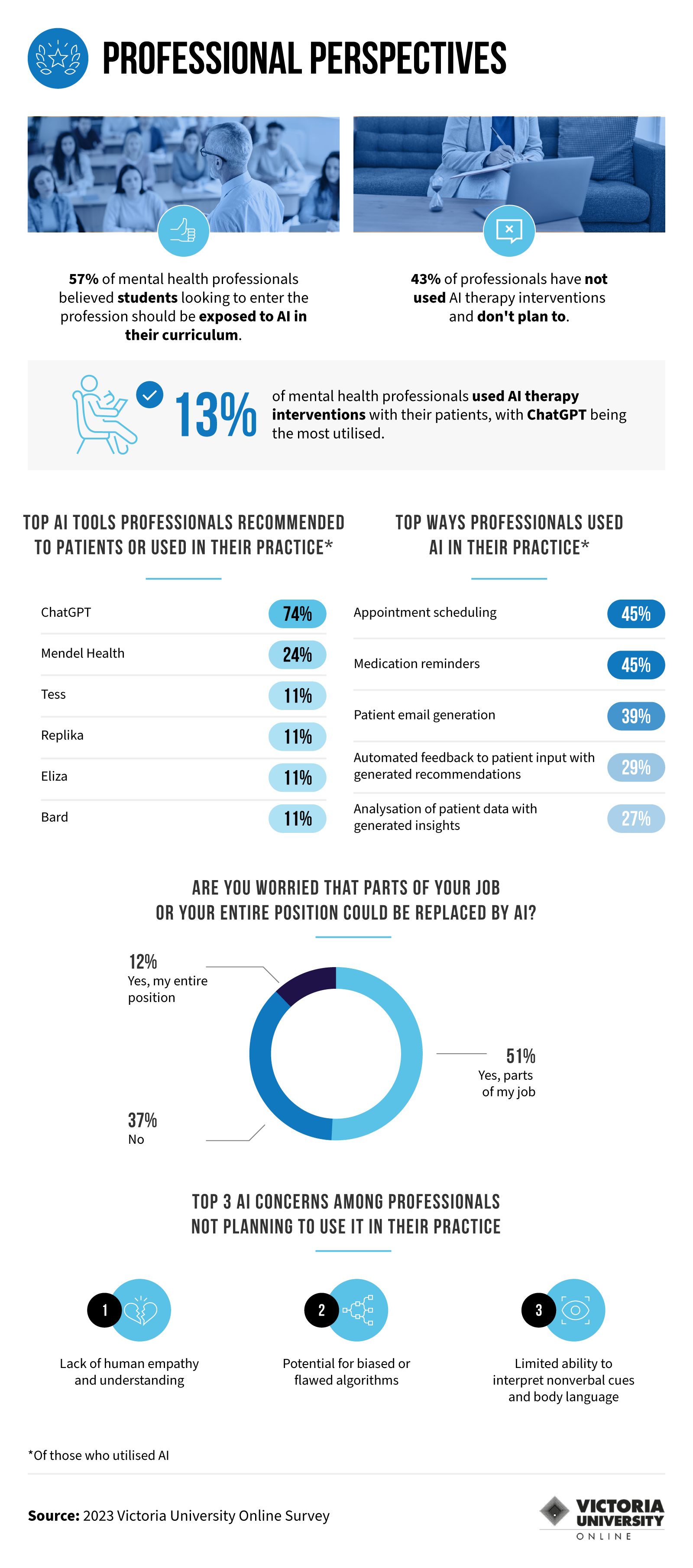
Transforming mental health care with AI
Key Takeaways
- The top three reasons people choose online therapy are convenience, comfort and cost.
- 37 per cent of people are open to a combination of AI and live-human treatment in therapy sessions.
- 51 per cent of mental health professionals are worried AI will replace parts of their job and 12 per cent are afraid it will replace their position entirely.
- 17 per cent of millennials would use an AI therapist.
- Over one in 10 mental health professionals have used AI in therapy interventions with patients and ChatGPT was their most used AI tool.
A new frontier in mental health
Artificial intelligence (AI) is being incorporated across a range of industries and the mental health field is no exception. To shed light on the potential benefits and challenges of integrating AI into mental health care, we surveyed 833 mental health patients and professionals in the United Kingdom and the United States.
In this article, based on market research conducted for VU Online, we’ll examine how AI is transforming the way professionals and patients approach mental health and gain insights into how they view this new technological frontier.
Patient perceptions
What do patients think about the role of virtual and AI-driven mental health care? We asked patients across multiple generations about their perceptions of these new avenues for mental health treatment.

Infographic Transcript
Therapeutic preferences
Do you prefer online or in-person therapy? Survey shows that:
- 19 per cent prefer both online or in-person therapy equally
- 28 per cent prefers online therapy
- 53 per cent prefers in-person therapy
- Millennials (people born from 1982 to 1995) were the most likely to prefer online therapy and the most comfortable with sharing personal details during online sessions
- 83 per cent of respondents believed human touch is essential in mental health treatment, providing empathy and reliability Al may lack
Top three reasons people preferred each therapy type:
- In-person: Face-to-face interaction, personal connection with therapist and perceived effectiveness.
- Online: Convenience, comfort and cost.
Are you open to a combination of AI and live-human treatment in therapy sessions? Survey shows that:
- 37 per cent said 'yes'
- 36 per cent said 'no'
- 27 per cent said that they're undecided
- 16 per cent of respondents said they would use an Al therapist and Millennials at 17 per cent were the most likely generation to say so
Source: 2023 Victoria University Online Survey
One of the biggest breakthroughs in mental health services is online therapy through telehealth and mobile apps. Gaining popularity among mental health patients, respondents to our survey opted for virtual treatment for its convenience, comfort and cost. Finding mental health support through remote therapy sessions can help decrease the time patients need to wait to talk to a therapist. Patients may also feel more comfortable expressing themselves within the privacy of their own homes. And while online therapy isn’t always cheaper than in person, the expanded variety of options may help make mental health services accessible to a larger portion of the population.
Interestingly, our survey revealed that 37 per cent of individuals were open to combining AI and live-human treatment during therapy sessions, suggesting a willingness to embrace technology as part of the therapeutic process. At the same time, 83 per cent of participants said the human element is still essential in mental health treatment. Human connection and interaction are vital to support individuals facing mental health challenges.
Breaking down the data further, millennials (born between 1982 to 1995) had the highest preference for online therapy. Compared to in-person treatment, millennials were more comfortable sharing personal details virtually. In fact, 17 per cent of millennials said they would consider using an AI therapist, indicating a greater openness among this demographic to explore alternative modes of therapy.
Advantages and concerns
While there are varying levels of hesitation surrounding AI in therapy, most respondents acknowledged its potential benefits. However, there is also still a need for careful consideration of ethical and practical implications in the integration of AI into mental health practices.

Infographic Transcript
AI advantages
47 per cent of mental health professionals and 35 per cent of patients said AI could benefit the mental health field.
1 in 10 millennials believed Al alone could successfully treat mental illness.
Top perceived advantages of integrating AI into therapy:
- Increased accessibility to mental health services—51 per cent
- Ability to analyse large amounts of data for personalised insights—30 per cent
- 24/7 availability of therapy resources—28 per cent
- Enhanced efficiency in diagnosing and treatment planning—28 per cent
- Improved accuracy in assessing mental health conditions—26 per cent
- Integration with wearable devices for more comprehensive tracking—24 per cent
- Cost-effectiveness for patients and providers—23 per cent
- Reduction of wait times for appointments—21 per cent
- Integration of cognitive behavioral therapy (CBT) techniques—19 per cent
- More personalised treatment options—19 per cent
Top concerns about integrating AI into therapy:
- Lack of human empathy and understanding—59 per cent
- Privacy and security of sensitive information—48 per cent
- Lack of cultural sensitivity and understanding—45 per cent
- Inadequate response to crisis situations or emergencies—45 per cent
- Difficulty establishing a therapeutic alliance with Al—41 per cent
- Potential for biased or flawed algorithms—40 per cent
- Limited ability to interpret nonverbal cues and body language—39 per cent
- Loss of the human touch and emotional connection in therapy—38 per cent
- Potential for over-reliance on technology and diminished human interaction—38 per cent
- Ethical considerations regarding the use of Al in mental health—36 per cent
Top three conditions professionals believed AI could help treat the most:
- Anxiety
- Depression
- Sleep disorders
51 per cent of respondents believed Al could enhance traditional mental health practices.
Source: 2023 Victoria University Online Survey
When it comes to the benefits of AI in the mental health field, professionals (47 per cent) showed a slightly higher level of optimism than patients (35 per cent). Nevertheless, a majority of respondents (51 per cent) acknowledged the potential for AI to enhance mental health practices.
Among the perceived advantages of using AI in therapy, 51 per cent of respondents ranked increased accessibility as the top benefit. Additionally, 30 per cent of respondents acknowledged the potential of AI in data analysis, which could lead to personalised insights and more targeted treatment approaches. Another 28 per cent of respondents highlighted faster diagnosis and treatment capabilities as a valuable advantage of AI.
However, respondents also raised some concerns regarding the use of AI in therapy. The foremost concern, expressed by 59 per cent of respondents, was lack of human empathy and understanding in AI. Privacy and security concerns were another prevalent worry, with 48 per cent of respondents expressing apprehension in this area. Additionally, 45 per cent of respondents were concerned about the potentially slow responses of AI systems in crises or emergencies, highlighting the need for prompt and efficient support in mental health care.
According to professionals, certain mental health conditions hold the most potential for AI implementation. They identified anxiety, depression and sleep disorders as the conditions with which AI could help the most. The ability of AI systems to analyse data, identify patterns and provide tailored interventions makes them well-suited to these particular areas of mental health.
The professional point of view
Professionals in all industries—mental health care included—are worried about AI taking over their jobs. However, AI can also provide ways for professionals to increase efficiency and excel in their roles.

Infographic Transcript
Professional perspectives
57 per cent of mental health professionals believed students looking to enter the profession should be exposed to Al in their curriculum.
43 per cent of professionals have not used Al therapy interventions and don't plan to.
13 per cent of mental health professionals used Al therapy interventions with their patients, with ChatGPT being the most utilised.
Top AI tools professionals recommend to patients or used in their practice (of those who utilised AI)
- ChatGPT—74 per cent
- Mendel Health—24 per cent
- Tess—11 per cent
- Replika—11 per cent
- Eliza—11 per cent
- Bard—11 per cent
Top ways professionals used AI in their practice (of those who utilised AI)
- Appointment scheduling—45 per cent
- Medication reminders—45 per cent
- Patient email generation—39 per cent
- Automated feedback to patient input with generated recommendations—29 per cent
- Analysation of patient data with generated insights—27 per cent
Are you worried that parts of your job or your entire position could be replaced by AI?
- Yes, my entire position—12 per cent
- No—37 per cent
- Yes, parts of my job—51 per cent
Top three AI concerns among professionals not planning to use it in their practice:
- Lack of human empathy and understanding
- Potential for biased or flawed algorithms
- Limited ability to interpret nonverbal cues and body language
Source: 2023 Victoria University Online Survey
AI has made its way into therapy interventions, with 13 per cent of our mental health professional respondents utilising it in their work. Among these professionals, the most widely used AI tool was ChatGPT, with a significant majority of 74 per cent.
However, 43 per cent of professionals who responded to our survey had not incorporated AI into their practice and did not plan to. The top three concerns of professionals regarding AI in mental health care were lack of human empathy and understanding, the potential for biased or flawed algorithms, and the limited ability of AI systems to interpret patients’ nonverbal cues and body language. These concerns highlight the importance of human connection and the nuances of nonverbal communication in therapy.
Even if professionals choose not to utilise AI in direct patient care, many AI tools can help them in their practice. The professionals we surveyed recognised the potential of AI in assisting them with various tasks, including scheduling appointments (45 per cent), scheduling medication refill reminders (45 per cent) and generating patient emails (39 per cent). These applications demonstrate how AI can streamline administrative and logistical aspects of mental health care, allowing professionals to focus more on direct patient interaction and treatment.
Despite its possible advantages, some mental health professionals may hesitate to use AI due to fear of job security. Over half (51 per cent) of those surveyed worried AI could replace certain aspects of their job and 12 per cent feared it might replace their position entirely. Still, mental health professionals recognised the significance of AI in today’s professional world, as 57 per cent believed students working toward a mental health degree should be exposed to AI and learn more about applying it in the field.
Leveraging AI in mental health care
While there are benefits and concerns associated with using AI in therapy interventions, it’s clear that AI could play a valuable role in enhancing accessibility, personalisation and efficiency in mental health practices. By leveraging AI tools and technologies, mental health workers can extend their reach, provide more tailored treatments and streamline administrative tasks, allowing them to focus more on direct patient care.
However, it’s crucial to approach the implementation of AI in mental health with careful consideration of ethical implications, addressing concerns such as preserving human empathy and preventing algorithmic bias. With proper integration and a human-centred approach, AI has the potential to revolutionise mental health care and contribute to better outcomes for individuals seeking support and treatment.
Methodology
This market research study was initiated to gather insights into mental health perspectives by surveying a diverse group of individuals, including both patients and professionals in the field.
Data collection period and platforms
The data collection phase spanned from June 22, 2023, to June 29, 2023, utilising the Connect Cloud Research and Prolific platforms. These platforms were selected for their wide reach and reliability, allowing us to engage with respondents from the United States, the United Kingdom and Australia. To ensure a representative sample and motivate participation, respondents were offered financial compensation for their time and input.
Participant demographics
A total of 833 individuals participated in the survey, categorised into mental health patients and professionals. The composition of the respondents was as follows:
- Mental health professionals: 94
- Mental health patients: 739
Participants were further segmented by age group, providing valuable insights into generational perspectives on mental health:
- Baby Boomers (Born 1946-1964): 45 participants
- Generation X (Born 1965-1981): 204 participants
- Millennials (Born 1982-1995): 476 participants
- Generation Z (Born 1996-2015): 108 participants
Respondents self-identified their relationship to mental health (patient, professional, or neither) to ensure data was analysed with an understanding of their personal or professional experiences.
Ethical standards and data integrity
Adhering to the highest standards of ethical research, this market research was designed and executed in compliance with the Code of Standards set by the Insights Association and the Market Research Society. A meticulous internal review process was applied to each survey, ensuring questions were formulated to elicit authoritative and unbiased data. This process underscores our commitment to producing reliable insights while respecting the ethical principles that govern academic and professional research.
Fair use statement
We’d love for you to share our insights on the ways AI is transforming mental health care. We just ask that it be for noncommercial purposes only and that you include a link back to this page so readers can access our full findings and methodology.



